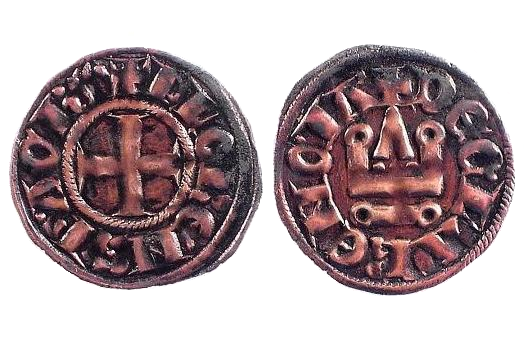
about ancient nomos
Ancient Nomos Art is a museum of galleries exhibiting ancient coins and ancient mint maps. The coin gallery displays the diverse art and history of hand-crafted ancient Greek, Roman, Byzantine, Persian and Medieval coinage. The ancient mints mapping gallery features Greek, Roman, Byzantine, Asia Minor and Medieval mint city regions and territories. Visitor's are welcome to explore, study and enjoy Ancient Nomos Art.

Medieval, Achaea – 1289 AD
Achaea, Greece
From Ancient Galleries

Obverse: Cross pattée in center with small cross above, spiral circle around.
Reverse: Chateau Tournois with four closed towers, cross atop center spire.
LEGEND
Obv: + (Cross) FLORЄNS • P • ΛCh’ (flower), Cross pattée within circular rope border. Rev: + (Cross) DЄ • CLΛRЄNCIΛ’, Medieval castle façade in center.
The billon silver Denier above was minted by the ruling Crusaders in Greece during the late 13th century. This coin was issued by prince Florent of Hainaut, second husband to Princess Isabelle de Villehardouin of Achaia. The Principality of Achaea was one of the three vassal states of the Latin Empire which reconstituted the Byzantine Empire after the French knight William of Champlitte led his forces and captured Constantinople during the Fourth Crusade. In 1204, Geoffrey I de Villehardouin, nephew of the famous historian, was granted Corinth, Greece, after the sack of Constantinople. He was given the title of Prince of Achaea. Following the capture of Thessalonica by Theodore, the despot of Epirus, in 1224 AD, Achaea became the dominant power in Greece, governed by the Villehardouin’s from their capital in Andravida of Elis. Achaea was rather small, consisting of the Peloponnese interior, but it was wealthy and by the mid-13th century the principality capital court at Andravida was considered to be one of the finest representations of chivalry by western Europeans. Prince William II Villehardouin was a poet and troubadour, and his court had its own mint, literary culture, and form of spoken French. As Prince, Florent negotiated the Treaty of Glarentsa with the Byzantine Empire and in 1289 was able to begin minting his own coins from Clarencia. The above coin reverse abstractly represents an image of the castle Tournois. The castle’s tower is form created using an engravers technique known as an unbarred Λ image type to depict the spire or pediment. A cross is mounted on top of the tower, as is typical with medieval imagery. The castle is surrounded by the legend; + DЄ • CLΛRЄNCIΛ’ (of Clarentza, where the medieval mint was located. The engravers spelling of the mint city Clarencia with a “c” (not the “t” as in Clarentia), is significant because it marks a linguistic shift away from the use of Latin. Achaea’s peace lasted until 1293, when the local Greek people retook Kalamata. However, Prince Florent was able to negotiate and persuade Michael VIII Palaiologos to return Kalamata to the principality of Achaea. In 1296, the Greek citizens again retook the castle of Saint George in Arcadia, which Prince Florent had earlier laid siege. Prince Florent soon died in 1298, before he could reclaim the castle. According to the Registri Angioni, the minting of coins in Achaea stopped after Florent’s death. When coin minting began again in 1299 they were issued in the name of Princess Isabelle. (A.G. Malloy)
DOCUMENTATION
Value: Billon Denier. Metal: AR Silver. Weight: 0.81 grams. Mint: Clarentza. Date:1289-1297 AD.
Attribution: L.F. de Saulcy, Numismatique Des Croisades, Plate XV; D.M. Metcalf, Oxford, Coinage of the Crusades, variety F2, 953-7; Coins of the Crusader States, 13a.
Legend, Documentation and Attribution
